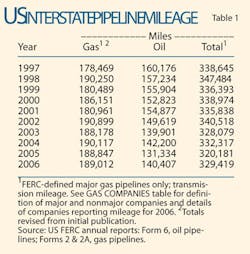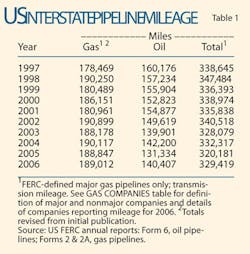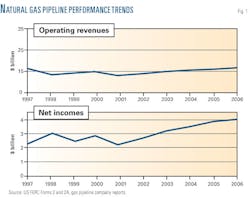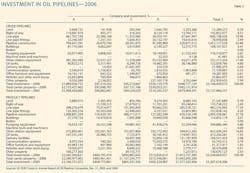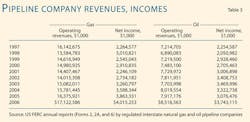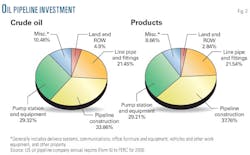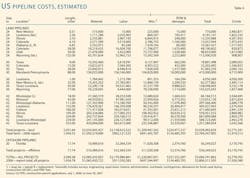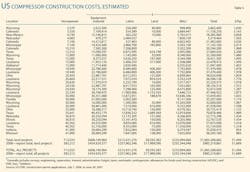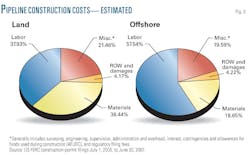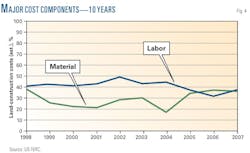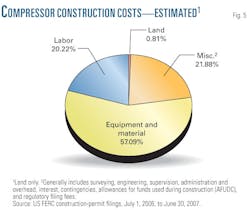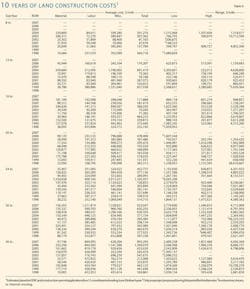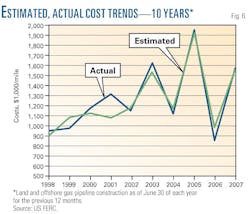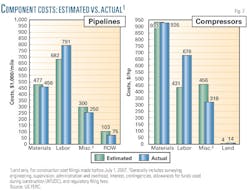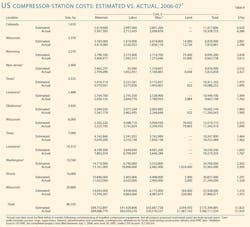SPECIAL REPORT: US oil carriers’ 2006 net incomes rebound; labor increases push up construction costs
US oil pipeline operators saw their net profits rebound in 2006, the more than $3.7 billion earned marking an increase of almost 18%, following a more than 7% dip in 2005. Oil pipeline operators’ profits equaled nearly 44% of revenue.
Natural gas pipeline operators, meanwhile, saw their net profits continue to grow, rising almost 4% to top $4 billion for the first time.
Operators also continued to use these profits to expand capacity. The number of formal construction plans brought before the US Federal Energy Regulatory Commission for new or expanded pipeline and compression fell for the 12 months ending June 30, 2006, but planned expenditures grew, tracking both the increased size of the proposed projects and increased expenses.
All of the proposed pipeline plans were for projects using pipe of 24-in. OD or greater, with 9 of 25 calling for 42-in. OD pipe. Proposed mileage also increased by more than 40%. Compression plans followed a similar pattern, with 16 of 32 projects calling for new or additional compression of 20,000 hp or greater and 4 calling for more than 40,000 hp.
The increased scale of the proposed projects had the anticipated effect on unit costs, with estimated $/mile pipeline costs jumping nearly 45% to more than $2.75 million, while $/hp cost estimates slipped 11.5%.
More than scale alone, however, drove the changes in cost estimates, surging labor prices passing material and miscellaneous costs as the single most expensive per-mile item.
Higher-cost labor also affected the balance between estimated and actual costs for both pipeline and compressor projects completed in the 12 months ending June 30, 2007. Actual pipeline costs were very close to estimated costs in aggregate, but higher than anticipated labor costs more than equaled lower than expected expenditures in every other category.
Higher than anticipated labor costs also contributed almost the entire difference between estimated and actual compressor costs, with projects completed by June 30, 2007, running more than $100/hp more expensive than had been predicted.
US pipeline data
At the end of this article, two large tables (downloadable PDFs) offer a variety of data for US oil and gas pipeline companies: revenue, income, volumes transported, miles operated, and investments in physical plants. These data are gathered from annual reports filed with FERC by regulated oil and natural gas pipeline companies for the previous calendar year.
Data are also gathered from periodic filings with FERC by those regulated natural gas pipeline companies seeking FERC approval to expand capacity. OGJ keeps a record of these filings for each 12-month period ending June 30.
Combined, these data enable an analysis of the US regulated interstate pipeline system.
- Annual reports. Companies that FERC determines to be involved in interstate movement of oil or natural gas for a fee are jurisdictional to FERC, must apply to FERC for approval of transportation rates, and therefore must file a FERC annual report: Form 2 or 2A for major or nonmajor, respectively, natural gas pipelines; Form 6 for oil (crude or product) pipelines.
The distinction between "major" and "nonmajor" is defined by FERC and appears as a note at the end of the table listing all FERC-regulated natural gas pipeline companies for 2006 at the end of this article (p. 64).
The deadline to file these reports each year is Apr. 1. For a variety of reasons, a number of companies miss that deadline and apply for extensions, but eventually file an annual report. That deadline and the numerous delayed filings explain why publication of this OGJ report on pipeline economics occurs as late as the third quarter of each year. Earlier publication would exclude many companies’ information.
- Periodic reports. When a FERC-regulated natural gas pipeline company wants to modify its system, it must apply for a "certificate of public convenience and necessity." This filing must explain in detail the planned construction, justify it, and--except in certain instances-specify what the company estimates construction will cost.
Not all applications are approved. Not all that are approved are built. But, assuming a company receives its certificate and builds its facilities, it must-again, with some exceptions-report back to FERC how its original cost estimates compared with what it actually spent.
OGJ spends the year July 1 to June 30 monitoring these filings, collecting them, and analyzing their numbers.
For 2001, OGJ began reporting what natural gas companies spent during the year on operations and maintenance (OGJ, Sept. 16, 2002, p. 52).
The table on natural gas companies has tracked how the US gas transmission industry has changed under reduced regulation.
OGJ’s exclusive, annual Pipeline Economics Report began tracking volumes of gas transported for a fee by major interstate pipelines for 1987 (OGJ, Nov. 28, 1988, p. 33) as pipelines moved gradually after 1984 from owning the gas they moved to mostly providing transportation services.
Volumes of natural gas sold by pipelines have been steadily declining, so that, beginning with 2001 data in the 2002 report, the table only lists volumes transported for others.
The company tables have also reflected the recent asset consolidation and merger activity among companies in their efforts to improve transportation efficiencies and improve bottom lines.
Reporting changes
The number of companies required to file annual reports with FERC may change from year-to-year, with some companies becoming jurisdictional, others nonjurisdictional, and still others merging or being consolidated out of existence.
Such changes require that care be taken in comparing annual US petroleum and natural gas pipeline statistics.
Institution by FERC of the two-tiered (2 and 2A) classification system for natural gas pipeline companies after 1984 further complicated comparisons (OGJ, Nov. 25, 1985, p. 55).
Only major gas pipelines are required to file miles operated in a given year. The other companies may indicate miles operated but are not specifically required to do so.
For several years after 1984, many non-majors did not describe their systems. But filing descriptions of their systems has become standard, and most provide miles operated.
Reports for 2006 show an increase in FERC-defined major gas pipeline companies: 73 companies of 118 filing for 2006, from 71 of 112 for 2005.
The FERC made an additional change to reporting requirements for 1995 for both crude oil and petroleum products pipelines.
Exempt from requirements to prepare and file a Form 6 were those pipelines with operating revenues at or less than $350,000 for each of the 3 preceding calendar years.
These companies must now file only an "Annual Cost of Service Based Analysis Schedule," which provides only total annual cost of service, actual operating revenues, and total throughput in both deliveries and barrel-miles.
In 1996 major natural gas pipeline companies were no longer required to report miles of gathering and storage systems separately from transmission.
Thus, total miles operated for gas pipelines consist almost entirely of transmission mileage. To continue to convey a 10-year trend, Table 1 has been adjusted to reflect only transmission mileage operated since 1995.
FERC-regulated natural gas and oil pipeline mileage increased in 2006 after having decreased in 2005 (Table 1). Final data show an increase of more than 9,000 miles, or nearly 3%.
This increase in majors-operated transmission pipeline mileage came largely on the back of a 13.73% increase in products mileage.
Rankings; activity
Major natural gas pipeline companies in 2006 saw operating revenues increase by more than $778 million or nearly 5% from 2005. The results were roughly similar when both major and nonmajor pipelines are considered, and in both cases grew in comparison to the $613 million move, more than 4%, seen for majors in 2005 from 2004.
This jump in revenues once again translated into the highest net incomes yet seen for either majors or all companies combined. Income for majors improved by more than 4%, or more than $160.5 million; with increases seen for all companies in 2006 of nearly the same 4%.
Income as a percent of revenues for natural gas pipeline companies, however, slipped to 23.45% in 2006 from 23.59% in 2005, breaking a string of five straight annual increases.
Oil pipelines saw even healthier gains in both revenues and income. Revenues increased by nearly $600 million or 7.6%, more than reversing the declines seen in 2005, while incomes rose more than $666.6 million or 21.7%, wiping out both the 7.4% decline seen in 2005 and the 4.2% decline of 2004.
Products deliveries for 2006 via pipeline rose 43.7 million bbl or 0.7%, only partially offsetting the losses seen in 2005. Crude oil deliveries, in contrast, were relatively flat. Throughput measured in million bbl-miles (bbl-mile: 1 bbl moving 1 mile) increased roughly 1.5%, by more than 51 billion bbl-miles, led by product throughput rising by more than 43.5 billion bbl-miles, or 2.3%
OGJ uses the FERC annual report data to rank the top 10 pipeline companies in three categories (miles operated, trunkline traffic, and operating income) for oil-pipeline companies and three categories (miles operated, gas transported for others, and net income) for natural gas pipeline companies.
Positions in these rankings shift year to year, reflecting normal fluctuations in companies’ activities and fortunes. But also, because these companies comprise such a large portion of their respective groups, the listings provide snapshots of overall industry trends and events.
Company financial data for all companies, not just the majors in both types of pipeline service, provide a view of the ongoing condition of these industries (Fig. 1; Table 3).
For all natural gas pipeline companies, for example, net income as a portion of operating revenues fell in 2006 to 23.45%, after having risen for 5 straight years to reach 23.59% in 2005. Income as a portion of operating revenues stood at 15.59% in 2001.
The percentage of income in operating revenues for oil pipelines had been hovering in the mid-20s for the first 5 years of the 1990s; for the last 10 years, however, it pushed first into the 30s, reaching almost 39% in 2001, and was in the 40s from 2002-04 (43%, 45%, and 41%, respectively).
Income as a percent of revenues retreated from these highs in 2005, dropping to 39%, but rebounded strongly in 2006, reaching nearly 44%.
Another measure of company performance and health is provided by a calculation of return on investment: net income as a portion of gas-plant investment. This traced the slight decline seen in income as a portion of revenue, moving to 4.55% following 4 consecutive years of gains that saw it top out at 4.6%. Even so, it remains close to the 4.7% levels last seen in 1998.
For oil pipelines, net income as a portion of investment in carrier property in 2006 resumed an upward trend begun in 1999, rising to 11.5% after having dipped to 10.4% in 2005. Income as part of investment in carrier property in 2004 stood at 11.4%, having risen steadily toward that level from 6.8% in 1998.
Major and nonmajor natural gas pipelines in 2006 reported an industry gas-plant investment of more than $88.3 billion, the highest level ever, up from nearly $84 billion in 2005, more than $83 billion in 2004, nearly $78 billion in 2003, $74.2 billion in 2002, almost $71 billion in 2001, $68 billion in 2000, and nearly $66 billion in 1999.
Investment in oil pipeline carrier property in 2006 rebounded from the lowest level seen since at least 1997, reaching almost $32.7 billion, after spending 2005 and 2004 relatively flat near $29.5 billion. This plateau followed a steep drop of nearly 8% between 2003 and 2004.
OGJ for several years has tracked carrier-property investment by five crude oil pipeline and five products pipeline companies chosen as representative in terms of physical systems and expenditures (Table 2). Starting in 2003, we added the base carrier-property investment to allow for comparisons among the anonymous companies.
The five crude oil pipeline companies in 2006 increased their overall investment in carrier property by more than $38.4 million, or 1.2%; the same grouping of companies increased overall investment in carrier property by nearly $108 million, or 3.6%, in 2005. One of the five companies has lowered its investment in carrier property for the past 2 years, despite the increases made by the group overall. A similar group of companies decreased investment in carrier property by 2.4% in 2004.
The five products pipeline companies increased overall investment in carrier property in 2006 by $182 million, or 3.39%, following a more modest $127 million, or 2.4%, increase in 2005 and a $509 million (nearly 11%) increase in 2004.
Comparisons of data in Table 2 with previous years’ must be done with caution: In 1998, a major crude oil pipeline company listed there merged with two other large pipeline companies. More transactions have followed, including the 2004 sale of significant assets by a major crude line also listed on the table, making comparisons with previous years’ data difficult.
Investment by the five product pipeline companies in 2006 was more than $5.5 billion and continued a return to growth that started in 2003 when investment of more than $4.7 billion was up from 2002’s $4.5 billion level.
Fig. 2 illustrates the investment split in the crude oil and products pipeline companies.
Construction stays strong
Applications to FERC by regulated interstate natural gas pipeline companies to modify certain systems must, except in certain instances, provide estimated costs of these modifications in varying degrees of details.
Tracking the mileage and compression horsepower applied for and the estimated costs can indicate levels of construction activity over 2-4 years. OGJ has been doing that since this report began almost 50 years ago.
Tables 4 and 5 show companies’ estimates during the period July 1, 2006, to June 30, 2007, for what it will cost to construct a pipeline or install new or additional compression.
These tables cover a variety of locations, pipeline sizes, and compressor-horsepower ratings.
Not all projects that are proposed are approved. And not all projects that are approved are eventually built.
Applications filled in the 12 months ending June 30, 2007, remained strong following a marked rebound in the construction of future gas pipelines along the US interstate system in 2005 and similar levels in 2006:
- More than 2,000 miles of pipeline were proposed for land construction, and 17.7 miles for offshore work. The land level is up from both the more than 1,450 miles proposed in 2006 and the 1,700 miles proposed in 2005. The offshore proposals were up from the 6.23 miles proposed in 2006, but still well below the 2005 total of 92 miles.
- New or additional compression proposed by the end of June 2007 reached more than 713,000 hp, continuing the upward momentum seen in 2006 when proposed horsepower more than tripled, reaching in excess of 583,000 hp from the nearly 175,000 hp envisioned by the pipelines in 2005 (Table 5).
Putting the continued rebound in US gas pipeline construction in some perspective, Table 4 lists 25 land-pipeline construction "spreads," or mileage segments, and 1 marine project, compared with:
- 42 land and 1 marine project (OGJ, Sept. 11, 2006, p. 46).
- 56 land and 4 marine projects (OGJ, Sept. 12, 2005, p. 50).
- 15 land and 0 marine projects (OGJ, Aug. 23, 2004, p. 60).
- 37 land and 3 marine projects (OGJ, Sept. 8, 2003, p. 60).
- 83 land and 3 marine projects (OGJ, Sept. 16, 2002, p. 52).
- 49 land and 2 marine projects (OGJ, Sept. 3, 2001, p. 66).
- 115 land and 6 marine projects (OGJ, Sept. 4, 2000, p. 68).
Further, of the 25 land pipeline projects applied for, 22 are for new pipeline as opposed to looping or replacement mileage. And of these 22, 12 are for pipeline of 50 miles or more in length, with 8 of these being for projects over 100 miles long (and 7 of the 8 of 42-in. OD).
For the 12 months ending June 30, 2007, the 25 land projects would cost more than $5.6 billion, more than twice the estimated cost of the 42 projects proposed in 2006.
The number and nature of these filings, pending actual progress on the projects themselves, continue progress in addressing the infrastructural needs associated with anticipated US natural gas demand growth.
Projects’ cost projections indicate much about where companies believe unit construction costs ($/mile) are headed. It is telling that the number and scale of projects remain strong despite high costs.
For proposed US gas pipeline projects 2006-07, the average land cost was $2.775 million/mile; in 2005-06, the average land cost was $1.92 million/mile; for 2004-05 the average land cost was $2.2 million/mile; for 2003-04 the average land cost was $1.7 million/mile; and for the 2002-03 period the average land cost was $1.28 million/mile.
Offshore costs per mile continued to slip. Projects proposed in 2006-07 cost $3.17 million/mile. Projects proposed in 2005-06 cost $3.5 million/mile. No offshore projects applied for in 2003-04. Those proposed in 2004-05 cost $6.07 million/mile, more than double the 2002-03 figure of $3 million.
Cost components
Variations over time in the four major categories of pipeline construction costs-material, labor, miscellaneous, and right-of-way (ROW)-can also suggest trends within each group.
Materials can include line pipe, pipe coating, and cathodic protection.
"Miscellaneous" costs generally cover surveying, engineering, supervision, contingencies, telecommunications equipment, freight, taxes, allowances for funds used during construction (AFUDC), administration and overheads, and regulatory filing fees.
ROW costs include obtaining rights-of-way and allowing for damages.
For the 25 land spreads filed for in 2006-07, costs-per-mile projections for the four categories all showed increases, with material and labor showing particularly sharp jumps, rebounding from the declines seen the previous year:
- Material-$1,011,471/mile, up from $728.189/mile for 2005-06.
- Labor-$1,052,658/mile, up from $621,917/mile for 2005-06.
- Miscellaneous-$595,552/mile, up from $476,692/mile for 2005-06.
- ROW and damages-$115,659/mile, up from $92,714/mile for 2005-06.
Table 4 lists proposed pipeline in order or increasing size (OD) and increasing lengths within each size.
The average cost-per-mile for the projects rarely shows clear-cut trends related to either length or geographic area. In general, however, the cost-per-mile within a given diameter indicates that the longer the pipeline, the lower the unit (per-mile) cost for construction. And, lines built nearer populated areas tend to have higher unit costs.
Additionally, road, highway, river, or channel crossings and marshy or rocky terrain each strongly effects pipeline construction costs.
Fig. 3, derived from Table 4, shows the major cost-component splits for land and offshore pipeline construction costs.
Material and labor’s combined portion of the cost for constructing land and offshore pipelines rose to nearly 75% of the cost. Labor rose most rapidly, passing material to return to the single largest portion of land construction costs. Labor’s portion of estimated costs for land pipelines moved to 37.93% in 2007 from 32.35% in 2006. Material costs for land pipelines also continued to rise, but slipped as a percentage of total costs in 2007 to 36.44% from 38.17% in 2006.
Fig. 4 plots a 10-year comparison of land-construction unit costs for the two major components, material and labor.
Fig. 5 shows the cost split for land compressor stations based on data in Table 5.
Table 6 lists 10 years of unit land-construction costs for natural gas pipeline with diameters ranging from 8 to 36 in. The table’s data consist of estimated costs filed under CP dockets with FERC, the same data shown in Tables 4 and 5.
Table 6 shows that the average cost per mile for any given diameter may fluctuate year to year as projects’ costs are affected by geographic location, terrain, population density, or other factors.
Completed projects’ costs
In most instances, a natural gas pipeline company must file with FERC what it has actually spent on an approved and built project. This filing must occur within 6 months after the pipeline’s successful hydrostatic testing or the compressor’s being put in service.
Fig. 6 shows 10 years of estimated vs. actual costs on cost-per-mile bases for project totals.
Tables 7 and 8 show such actual costs for pipeline and compressor projects reported to FERC during the 12 months ending June 30, 2007. Fig. 7, for the same period, depicts how total actual costs ($/mile) for each category compare with estimated costs.
Per-mile pipeline construction costs for completed projects jumped by more than 86%, led by higher than estimated labor costs. It cost roughly the same amount to build a total of 317.84 miles of pipeline in the 12 months ending June 30, 2007, as it did to build 594 miles of pipeline in the year-earlier period. Material costs were lower, in line with the smaller mileage constructed, with both miscellaneous and ROW categories relatively flat.
Actual costs were only 1.2% higher than projected costs for the 12 months ending June 30, 2007, as some increase in the price of labor had been anticipated, just not the amount that occurred.
Some of these projects may have been proposed and even approved much earlier than the 1-year survey period. Others may have been filed for, approved, and built during the survey period. If a project was reported in construction spreads in its initial filing, that’s how it is broken out in Table 4. Completed projects’ cost data, however, are usually reported to FERC for an entire filing, usually but not always separating pipeline from compressor-station (or metering site) costs and lumping several diameters together.
The 12 months ending June 30 saw more than 96,000 hp of new or additional compression completed, continuing recent declines that saw nearly 106,000 hp completed in 2006, and 153,000 hp of new or additional compression were reported in 2005 vs. 468,000 hp in 2004.
More than a fifth of the 2006-07 horsepower was from a single project.
Overall, actual land gas pipeline construction costs came in less than $40,000/mile above estimated costs. Table 8 shows a similar trend between installed and estimated compression costs, with actual costs higher than estimated and the largest discrepancy seen in labor costs ($431/hp estimated vs. $676/hp actual).
Click here to download a PDF of the Oil pipeline companies table
Click here to download a PDF of the Gas pipeline companies table
